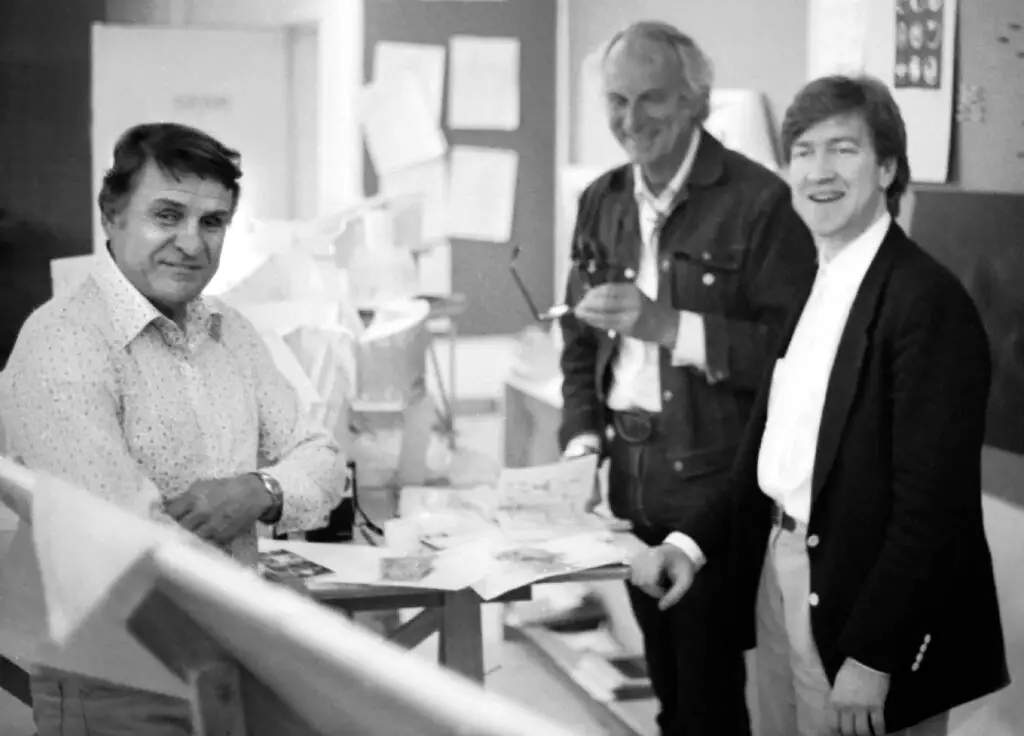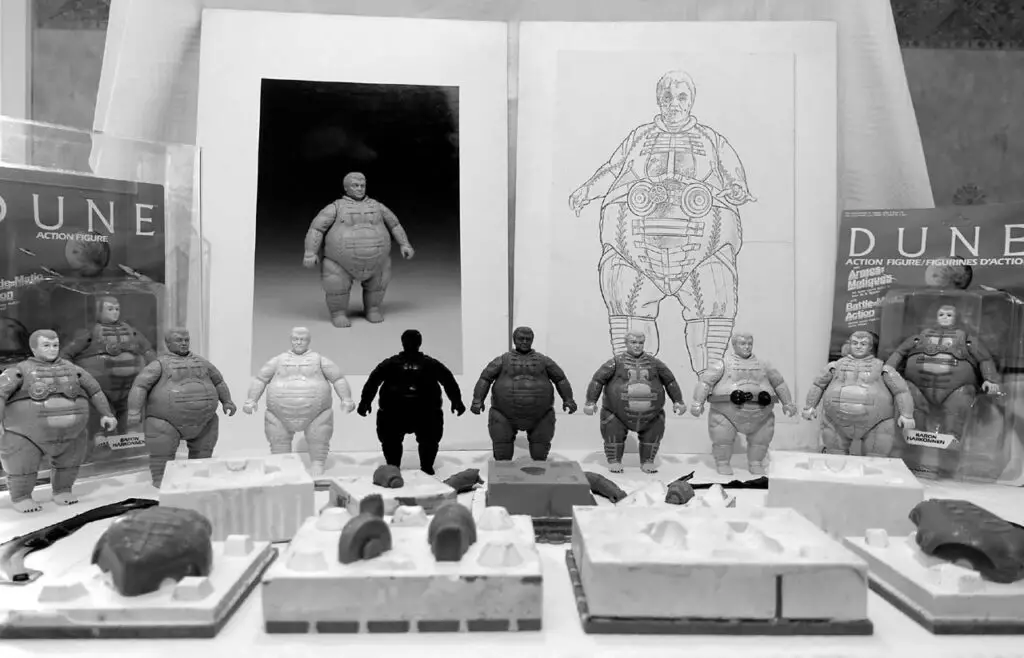My introduction to the universe of Dune was through David Lynch’s movie adaptation (1984). That was the early 1990s when it was broadcast on Channel 4 here in the UK. A few years later, while at university, I found a great second-hand book shop and picked up the first novel to read. I then bought Dune Messiah, followed by Children of Dune, and eventually the entire Dune series by Frank Herbert. The shop also provided me with the Dune Encyclopedia (which was incredibly cheap back then) and The Making of Dune by Ed Naha.
That book covered the behind-the-scenes story of how Lynch’s film came to be, and despite being an official book, was surprisingly honest about the problems faced during production, with broken bones, third degree burns, fires, the SFX crew leaving, and more. Naha’s book will always have a special place in my heart, as it was that book that led me to create my original “Dune – Behind the Scenes” website way back in 1994.

A Masterpiece in Disarray by Max Evry is a spiritual successor to the Making of Dune, with the benefit of almost 40 years’ worth of hindsight, the ability to assess the film’s initial reception, as well as its lasting legacy. The first thing you’ll notice about this new book is its size, at over 550 pages, it is longer than Herbert’s novel and thick enough to stop several Hunter-Seekers. Max addresses the length at the start, noting that the history of Lynch’s Dune has been under-served compared to sci-fi fare such as Star Wars or Star Trek, and he is “making up for lost time.”
The book is broken down into four main sections (Pre-Production, Location, Post-Production/Release, and Legacy), with each section further divided down into smaller topics. Each main section contains Oral Histories, compiled from new interviews conducted by Max with an impressive array of cast and crew of Dune, as well other notable filmmakers, writers, and Dune fans. Max encourages you to follow your own Golden Path, be that starting at page one and continuing to the end, or jumping around, gathering information like Spice upon the sands of Arrakis.

Pre-Production
This first section starts with the almost mandatory history of Frank Herbert and his road to publishing Dune, followed by a quick, but comprehensive coverage of the previous attempts to bring Dune to the silver screen by Arthur P Jacobs, Alejandro Jodorowsky, and Ridley Scott, before David Lynch enters the frame.
With the success of The Elephant Man (1980), Lynch was the hot new director in Hollywood. His meeting with George Lucas to discuss directing Return of the Jedi (1983) is well documented, but that wasn’t the only potential next movie on the table, and Max explores those many—and surprisingly diverse—films that Lynch was linked to before Dune.
Ultimately Dino De Laurentiis secured Lynch for Dune, and the book kicks into high gear, digging deep into the design and scripting process before getting to one of the biggest new discoveries in the book: the casting. Over the years various names have been linked to Dune, sometimes from reliable sources, but often just rumor and hearsay. Max puts all debate to rest by going straight to the source – the original 1982 casting notes! There are many surprising names which I won’t spoil, other than to say that in an alternative Dune-iverse Feyd, Rabban, and Baron Harkonnen could have been played by Patrick Swayze, Kevin Costner, and drag-queen Divine!

The first Oral History ends this section, featuring nearly 30 interviewees, including some highly recognizable names: Kyle MacLachlan, Sean Young, Raffaella De Laurentiis, and Toto members David Paich and Steve Lukather. These interviews are edited together to explore various themes and topics, giving almost the feeling that everyone was sat around a giant table in conversation, rather than these all being separate interviews, and the approach works extremely well.
Production
The next section of the book covers the actual filming of the movie, and if you have read The Making of Dune you may be familiar with many of the stories concerning the location, costuming, the practical effects of the Guild Navigator, onset mishaps, and the actors’ experiences. Max also draws from many other sources, making this much more than a remix of Ed Naha’s book. The highlight is again the Oral History, with recollections of the highs and lows of making a Hollywood blockbuster in Mexico.
Post-Production and Release
After principal photography had finished, and the cast had flown home, there was still all the visual effects to finish. Things got complicated when Apogee, the company hired to do those effects, quit! Not to mention the challenge of editing down many hours of footage into just two hours and 17 minutes.
With The Making of Dune book coming out with the film’s release in December 1984, the rest of story has largely been untold until now – the bizarre merchandising of activity books featuring dead bodies to color in, action figures with black toenails, and the very short-lived Dune Fan Club. An interview with comic book artist Bill Sienkiewicz reveals that he was working with very little visual reference for the film, but perhaps we can be thankful for that. His comic adaptation for Marvel was much more abstract than a literal frame-by-frame version of the film than is the case with the Dune (2021) adaptation.

Lynch’s Dune was not well received in the press… The book details some of the marketing missteps, taken by Universal, that may have alienated the press and given them a negative impression of the film before they’d even seen a single frame. The reprinting of some of those classic reviews gives a sense of the largely negative reaction at the time.
After leaving the cinema, Dune found its home on video releases, from Laserdisc and VHS to the recent 4K Blu-ray release. The infamous “Alan Smithee” TV edit is an abomination but was a missed opportunity for Universal to do right by Lynch as we learn. Fan edits sprang up following the availability of additional deleted scenes on DVD, and Max talks to Spicediver about his version, which is a fan favorite. Once again, the Oral History is a gold mine, especially the interviews with two Presidents of Universal Pictures. These reveal some of the inner workings of the studio, at the time, as well as Universal’s dealings with Dino De Laurentiis and Dune.
Legacy
The aftermath, both bad and good, of the movie’s commercial failure on the crew is covered, as well discussions with director James Cameron on the imagery in Lynch’s Dune.
The impact of Star Wars on pop culture was instant and expansive, whereas Lynch’s Dune was like a slow blade that took many years to penetrate the public’s consciousness. Even then, references in film and TV shows are often subtle, but Max details the many nods to Lynch’s movie, and even interviews the writer of the episode “Chuck Versus the Sandworm” (2007) from the TV series Chuck, one of the more obvious references that wears its love of the film on its sleeve.
Beyond film and TV, the 1984 movie’s influence is seen in the Cryo and Westwood computer games—sometimes even including footage within the game itself—it can be heard in music that uses audio samples from the movie or lifting lines from its dialogue for their lyrics. Artists have drawn on Lynch’s beautiful imagery for inspiration, and Max talks to Matt Griffin, who has found himself providing artwork for the official Dune novels too.
Dune eventually returned to our screens in 2000 with the miniseries, and in 2021 with Denis Villeneuve’s film, with a few more failed attempts in between. Each faced having its adaptation compared to the book, and its look compared to the splendor of Lynch’s epic.
Max then talks to over a dozen contemporary film critics about their thoughts and memories of Lynch’s Dune, and any lasting impressions.
The examination of the impact of Dune on so many aspects of pop-culture does go into great detail in places, and perhaps becomes less about Lynch’s Dune than personal connections to the movie by fans, losing part of the otherwise highly focused narrative of the book, but the it ends on a high note!…
The book concludes with something which is rarer than Fremen tears, and greater than treasure – an interview about Dune with David Lynch himself! While short, it is still an insightful interview, and Lynch’s relationship with Dune is clearly not a straightforward as hating the entire experience.

Reaction
This is exactly the sort of book I’ve been wanting on Lynch’s Dune for years, pulling together many historical resources and providing new information directly from the people involved in making the film that got me into Dune.
It is thoroughly researched, with all the quotes’ origins referenced in the text, but it would have been nice to have a single appendix at the end listing all the magazines, documentaries, and YouTube links should readers want to explore further.
There are several photographs, mainly on the 32 pages in the middle of book, but, with Lynch’s Dune being highly visual having some additional photos spread out over the book may have helped break up the text.
Of course, adding an appendix and more photos would have only made the book even longer, and its length might frighten some readers off, but remember – fear is the mind killer.
It almost feels like this book could have been written for me, which perhaps will limit its appeal to those who likewise believe that the movie is, indeed, a Masterpiece in Disarray.

Further Reading: The Making of Dune by Ed Naha. This book is sadly out of print, but is often to be found on eBay, or can be read online at the Internet Archive.
Note: This review was based on an advanced copy and the final book may have slight differences. Many thanks to 1984 Publishing for providing the Dune News Net team with copies for this book review.
Disclosure: I was interviewed for this book and provided some of the images.



